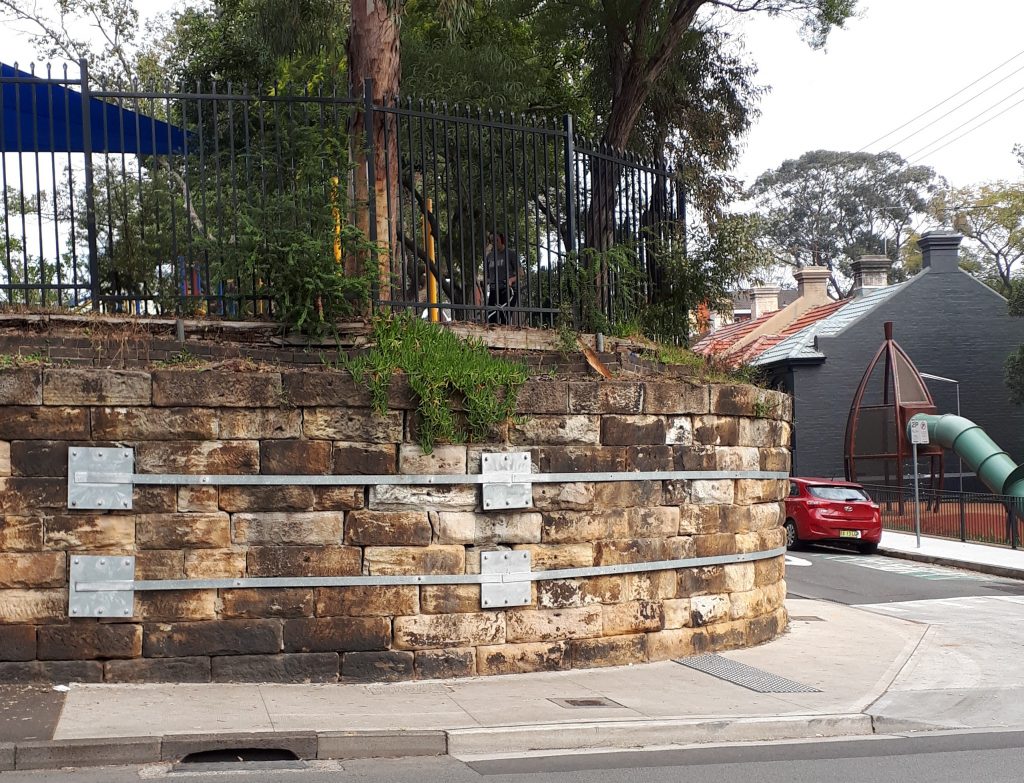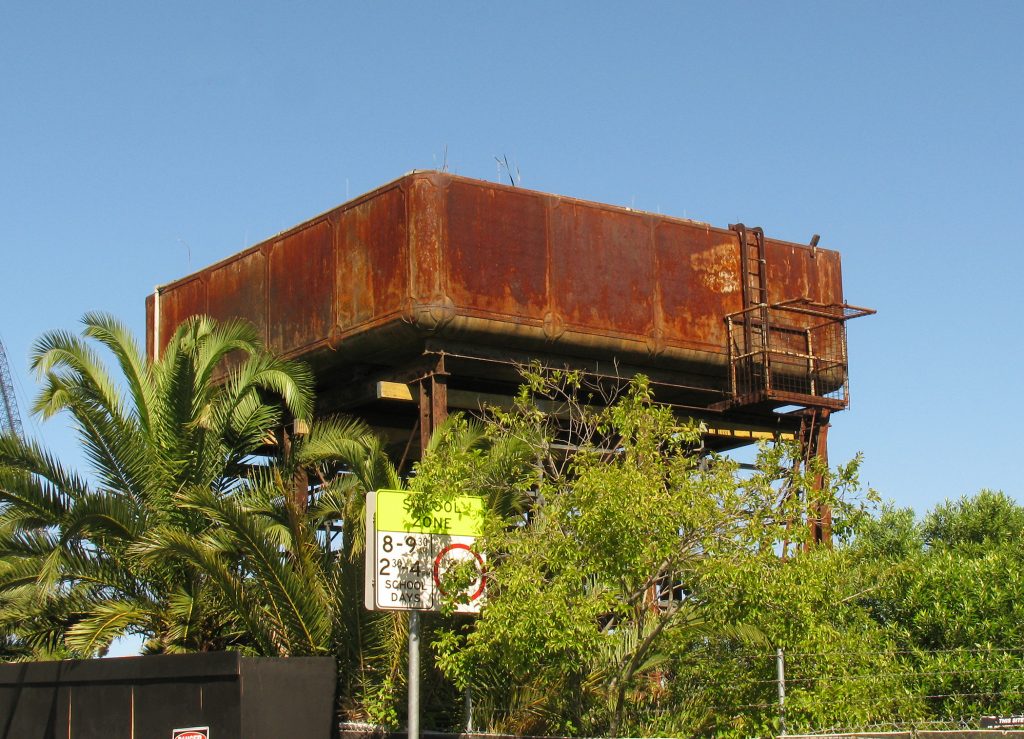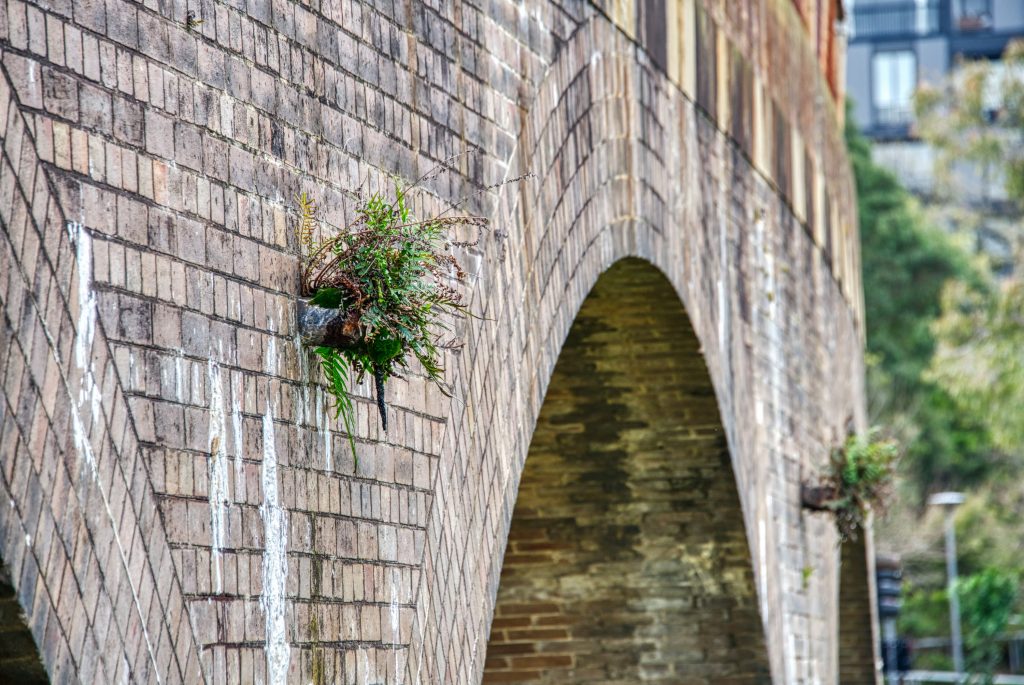By Ted McKeown, for Bulletin 7 of 2020 (September 2020)
No matter how hard we try, there are some heritage issues that seem to take forever to resolve. Here is a selection.

Forest Lodge Public School – retaining wall ‘repair’
Back in 2014, the Department of Education carried out what they said were urgent works to ‘stabilise’ the sandstone retaining wall at Forest Lodge Public School at the corner of Ross St and Charles St, Forest Lodge. This wall is a significant heritage item in Forest Lodge, marking the entrance to the tramway leading to the Rozelle Depot, later upgraded to a road for vehicles other than trams and named Minogue Crescent. There is a corresponding wall on the Eastern side of Ross St at its intersection with Bridge Rd.
Some years ago, both walls showed signs of deterioration. The Eastern wall, which forms the boundary of what was then Ronald McDonald House, was partially demolished, stabilised, and then rebuilt using the original sandstone blocks – an entirely appropriate repair. The Department of Education, however, saw fit to ‘repair’ its wall by using hideous metal bracing strips and plates, clearly an engineer-driven solution with absolutely no regard to the historic and aesthetic qualities of the site and the structure.
The City Council did not even know that the work had been carried out until we drew it to their attention. More in sorrow than in anger, the Council wrote to the Department, ticking it off for doing the work without any kind of approval – a bit of a slap over the wrist with a limp lettuce. But it did sum up by saying:
The Engineer’s report details that a further assessment of the retaining wall will need to be carried out in the future. The City has provided the following recommendations to the Department of Education on this matter to consider prior to carrying out any further works in the future.
1. Any future assessment of the retaining wall recommended in the Engineer’s Report, it would be recommended by the City that the assessment be carried out with the assistance of a suitably qualified and experienced heritage practitioner, who is to give input in the process, ensure appropriate heritage outcomes and to prepare a heritage impact statement.
2. The recent works be reassessed with a view to coming up with solutions that will have less of a visual impact on the sandstone walling than that which has recently been carried out at the corner of Ross St and Charles St.
3. If the works proposed arising from the assessment are likely to have more than a minimal heritage impact, as determined in the heritage impact statement, they will not be exempt under the Infrastructure State Environmental Planning Policy and a Development Application will be required.
In other words, do it again, do it properly, and tell us before you do so.
Five years on, we and the Council are still waiting.
Having got nowhere with the Department, we enlisted the aid of Councillor Linda Scott, who wrote to the then Minister for Education, Adrian Piccoli. The Department’s reply on the Minister’s behalf was a masterpiece of obfuscation:
The Department of Education recognises that the retaining wall at the School is of historical significance and is listed on the Council’s Local Environment Plan.
The safety of students, staff and school community is a top priority for the Department. Following safety concerns due to the condition of the retaining wall, the Department engaged a structural engineer to assess and provide advice. At the advice of the structural engineer emergency works were carried out to the retaining wall to address the safety concerns.
The Department of Finance, Services and Innovation has launched the Minister’s Stonework Program (MSP) to address maintenance of NSW Government owned sandstone buildings and structures. A component of the MSP is the 10-year Schools Stonework Program (SSP), which focuses on addressing maintenance of stonework in NSW public schools. As part of the SSP, stone works at Forest Lodge Public School will be assessed for funding against competing stone works projects in schools across the State.
So now, as it says in the beer advertisement, we wait … and wait, and wait. Perhaps we can draw some comfort from the fact that the ‘10-year SSP’ should be fully implemented by 2026.
But don’t count on it.

Water Tank at Tramsheds, Harold Park
On 5 June 2019, I emailed Anthony Green, the Project Director, Residential Development, at Mirvac. I was trying to find out what was happening with regard to the Water Tank at Harold Park, which was removed for conservation and re-erection when the Tram Sheds were developed by Mirvac. The City Council had confirmed that this was the responsibility of the company as developer.
The Development Control Plan (Harold Park) 2011 (p. 21) says that the Water Tank adjacent to Maxwell Rd is of heritage significance as part of an early Grinnell automatic fire sprinkler system, which saved the Tram Depot from fire in 1919. One of the objectives of the DCP was to ‘ensure conservation and retention of the former Tram Depot including the tram sheds, curtilage, the administration building, four nominated trams and the water tank’. We were rather concerned that nothing seemed to be happening with regard to the Water Tank, and the Council didn’t (and doesn’t) seem to have pursued the issue with any great determination.
I pointed out that the Society was instrumental in 2018 in the return of the Rozelle Tram Depot War Memorial to its original location at the Tram Sheds, and that we would very much like to see the Water Tank restored to, or close to, its original location as well.
A year later, on 2 June this year, Mr Green eventually responded to say:
We are still working our way through the design of the water tank with our design team and Council. Please be assured that the water tank installation will be delivered by Mirvac as soon as practically possible. Given the dilapidated state of the tank and the fact that it will be an item owned by the City of Sydney, it will need to undergo significant modification and interpretation to ensure it remains accessible.
We are not quite sure what ‘significant modification and interpretation’ means, but we remain hopeful.
Watch this space.

Wentworth Park Viaduct
The light rail viaduct at Wentworth Park is listed on the State Heritage Register, its Statement of Significance reading:
The Glebe Viaducts across Jubilee Park and Wentworth Park have state significance as excellent examples of large scale brick arch bridge construction. The 28-span Jubilee Park Viaduct is significant as the longest section of brick arch viaduct on the NSW system. Along with the 21-span Wentworth Park Viaduct, the pair of elegant curved structures are integral parts of the parklands in which they stand and remain as important landmarks along the Glebe foreshore. The structures are both major engineering works and are historically significant as important elements in the development of the Darling Harbour Goods Line in the early 20th century, and as one of the first major infrastructure projects to use bricks from the State Brickworks at Homebush, with more than 3 million bricks used in their construction.
Initially, I was told by the Council that the maintenance of the viaduct was a matter for the Council, but it turned out eventually that this was a matter for Transdev Sydney Light Rail. So early in 2019 I contacted Transdev, and explained that the brickwork was being significantly damaged by bracken, figs and other weeds growing out of cracks between the bricks.
Eventually, on 4 December 2019, I received the following reply:
Thank you for your patience whilst we investigated your concerns,
We will be conducting detailed inspections of the under-bridges (including the viaducts) in January and will be developing a comprehensive maintenance program based on the results of the engineering inspections.
We will be conducting vegetation removal during the inspections as far as possible and any remaining work will be prioritised by the engineers according to critical and scheduled accordingly.
Having heard nothing further, I followed up on 1 June 2020. This time the response was short and to the point:
Thank you for your follow up email. I have forwarded this to the relevant teams who are reviewing and will provide me with an update shortly. Once I received [sic] I will provide you with an update.
Predictably, there has been no further correspondence, and absolutely no action on the viaduct, but we will persist for as long as it takes.
Again, watch this space.
Glebe Island Bridge
Don’t even get me started!
It almost defies belief that a Government-owned item on the State Heritage Register is being demolished by neglect, but this is a topic for more serious discussion at a later date.











There are no comments yet. Please leave yours.